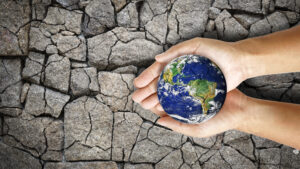In this edition of Risk Alerts, Carrier Management highlights the dangers of falling space junk, more frequent and severe megadroughts, toxins in bioplastics, risky bridges, and the physical and mental health impacts of climate change.
Falling space junk
A cylindrical object crashed into a Florida home in March, tearing through the roof and two floors. In April, NASA confirmed the object was from the International Space Station and that it came from a cargo pallet of aging batteries that was released from the ISS back in 2021.
NASA said the object was a support component used to mount the batteries on the 5,800-pound (2,630-kilogram) pallet released from the space station. Made from Inconel (a metal alloy that can withstand extreme environments like high temperature, pressure or mechanical loads), the object weighs 1.6 pounds and measures four inches high by 1.6 inches in diameter.
While it’s not unheard of for space-related junk to find its way back to Earth, such debris typically burns up in the atmosphere. NASA said that also should have happened in this incident.
“The hardware was expected to fully burn up during entry through Earth’s atmosphere on March 8, 2024,” said NASA. “The International Space Station will perform a detailed investigation of the jettison and re-entry analysis to determine the cause of the debris survival and to update modeling and analysis, as needed.”
Sources: “NASA confirms origin of space junk that crashed through Florida home,” The Verge, April 16, 2024; “NASA Completes Analysis of Recovered Space Object,” NASA Blog, April 15, 2024

Megadrought
Typical droughts last for a season or a few years; the ongoing megadrought in the western U.S. has been going on for 23 years.
Data from tree rings reveals the current megadrought is the most severe the region has experienced in at least 1,200 years, according to research by West Virginia University Assistant Professor Steve Kannenberg.
Among the consequences of this crisis:
- Landscapes may change permanently, as some species die out and those better suited to the new conditions move in.
- Reservoirs could shrink to critical levels, causing many cities and towns to enforce water restrictions.
- Wildfires and dust storms will become more frequent and intense.
“Globally, megadroughts are projected to increase in frequency and severity in the coming decades,” warned Kannenberg.
As the Earth warms, dry areas will likely become drier, and droughts will be worse, he said. “Historically, megadroughts are a rare, rare thing, but there have been a number of them throughout time, and they’re going to get more frequent and more severe in the future.”
Sources: “Megadrought in the western U.S. is the worst in at least 1,200 years,” Earth.com, April 18, 2024; “WVU researcher studying worst western US megadrought in 1,200 years,” West Virginia Today, WVU News, April 17, 2024
Bioplastics
Emerging research shows that plant-based plastics contain thousands of synthetic chemicals, some of them extremely toxic.
While plant sources for bioplastics, such as corn or cane sugar, may not themselves be toxic or have adverse health impacts, the same can’t be said for the chemical processes to manufacture bioplastics and the many additives needed to give them their attributes (hardness, durability, flexibility, color), said Bethanie Almroth, a professor of ecotoxicology and environmental science at the University of Gothenburg, Sweden.

In a 2020 study, researchers purchased bio-based plastic products such as food wrappers, food storage bags, reusable coffee cups, tea bags, disposable cutlery and coffee capsules. They also obtained raw materials (bio-based plastic pellets) at a plastics trade fair. In the multipart study, the scientists first analyzed the pellet samples and found a complex mixture of thousands of chemicals, most of them unidentifiable. Next, the researchers exposed bacteria to extracts of the bioplastics; they found that the majority had multiple toxic effects.
For a 2023 study published in Environmental Pollution, Almroth and her team placed plastic and paper cups lined with the bioplastic PLA in sediment and freshwater for up to four weeks. When they added the contaminated water to a tank with mosquito larvae, they discovered the same level of mortality, inhibited growth and deformities as when larvae are exposed to petrochemical-based polystyrene and polypropylene.
The researchers say that whether made from plants or petroleum, the processed plastics comprise the same synthetic chemicals. Both types of plastics can also contain accidental contaminants, they warn, while bio-based plastics may include pesticide contaminants.
Source: “Bioplastics as toxic as regular plastics; both need regulation, say researchers,” Mongabay, April 22, 2024
Vulnerable bridges
The collapse of the Francis Scott Key Bridge in Baltimore has highlighted potential vulnerabilities among some of America’s more than 600,000 bridges, according to a recent CNN report.
When the Dali, a ship weighing more than 100,000 tons, smashed into the 47-year-old bridge, it fell in less than a minute. Recent federal safety inspections of the Francis Scott Key Bridge found it to be in “fair” condition, and Maryland’s governor said the bridge was “fully up to code.” But thousands of U.S. bridges are in bad shape.
According to the American Society of Civil Engineers and the federal government, 46,000 bridges have aging structures and are in “poor” condition, and 17,000 are at risk of collapse from a single hit.
Extreme weather events, earthquakes, increasingly heavy trucks and collisions from larger container ships pose significant risks to U.S. bridges, engineers and other infrastructure experts say.

Nearly 21,000 bridges were found to be susceptible to having their foundations threatened during extreme weather events such as hurricanes or elevated heat, according to the American Society of Civil Engineers’ 2021 report.
Heavier trucks, which can surpass 40-ton loads, threaten to over-stress bridge elements, cause metal fatigue and cracking, and decrease bridges’ lifespans, the report said.
More than 17,000 bridges are vulnerable to collapse from a single hit, known as a “fracture critical” bridge. That means that if they are struck with enough force in just the right spot, a big section or the entire bridge could collapse.
The Dali was 984 feet long—nearly twice the length of the ships used when the bridge was built.
“Ships have gotten bigger, and container ports are focused on deepening their cargo. While we are encouraging bigger containers, we need to protect bridges in these one-off situations,” Ananth Prasad, president of the Florida Transportation Builders’ Association, told CNN.
Source: “1 in every 13 bridges in America is in ‘poor’ condition. Thousands could collapse from a collision,” CNN, March 30, 2024
Climate vs. Health
Climate change is impacting the spread of infectious diseases, according to a recent study published in JAMA.
Vector-borne diseases like dengue, malaria and Zika are caused by pathogens carried by mosquitoes, fleas and ticks. Changing rain patterns are expanding vectors’ range and their active periods, experts say. Shorter, warmer winters and longer summers are also linked to more vector-borne diseases.
“We’re seeing cases of tick-borne diseases in January and February,” said Matthew Phillips, an infectious diseases fellow at Massachusetts General Hospital and Harvard Medical School, one of the study’s authors. “The tick season is starting earlier and with more active ticks in a wider range. This means that the number of tick bites is going up and with it, the tick-borne diseases.”
Another concern is malaria. The mosquitos that transmit the disease are expanding northward, a climate-induced change. Changing rain patterns have led to more mosquitos and a higher disease transmission rate.
“As an infectious disease clinician, one of the scariest things that happened last summer was the locally acquired cases of malaria. We saw cases in Texas and Florida and then all the way north in Maryland, which was really surprising. They happened to people who didn’t travel outside the U.S.,” Phillips said.
The study also pointed to the emergence of new fungal infections, such as Candida auris, and changes in the location of some fungal pathogens and zoonotic diseases, such as plague and hantavirus.
Changes in rain patterns and coastal water temperature can also affect the spread of waterborne diseases, such as E. coli and Vibrio. According to the team, the sea level is rising, and storm surges and coastal flooding that used to be rare or extreme events are happening more frequently.
Climate change is also worsening conditions like dementia, epilepsy and depression, according to a new study from University College London. The researchers found that environmental factors not only affect the prevalence of neurological diseases and mental health disorders but can heighten the associated risk of hospital admission, disability and even death.
“In order to work properly, the brain has to be maintained within a relatively narrow temperature range,” Sanjay Sisodiya, a professor at the UCL Queen Square Institute of Neurology who led the research, told Bloomberg. “If the brain has a disease, then the brain’s ability to thermoregulate is compromised. Take someone with a neurological disease and put them in an extraordinary heat wave, you can see how that could well make their neurological disease worse.”
The researchers reviewed 332 reports looking at environmental impacts on 19 neurological conditions with the highest disease burdens, including Alzheimer’s and other forms of dementia, migraine, stroke, multiple sclerosis and meningitis. They also gathered research on depression, anxiety and schizophrenia as psychiatric disorders have frequent comorbidity with neurological diseases. The findings show weather impacts each disease in distinct ways, but most conditions are broadly associated with higher prevalence and worsened symptoms.
Extreme weather events such as storms and wildfires can trigger acute cases of anxiety, post-traumatic stress, depression and suicidal ideation. The research found that extreme cold can take a toll on health as well.
“What scares me most about this scenario is that by 2050, not only will we see an explosion of people with neurological disorders, but it will happen in our 40s and 50s instead of 70s and 80s because our brains are bombarded by different stresses like heat, pollution and microplastics,” said Burcin Ikiz, a neuroscientist who studies the impact of environmental patterns on the brain. Ikiz is also founder and chair of the International Neuro Climate Working Group, an initiative to promote more research and advocacy around climate change’s threat to the brain.
Sources: “Experts warn climate change will fuel spread of infectious diseases,” UC Davis Health, March 20, 2024; “Climate Change Is Affecting Brain Health, Study Finds,” Bloomberg, May 15, 2024





















 Five AI Trends Reshaping Insurance in 2026
Five AI Trends Reshaping Insurance in 2026  Artificial Intelligence Is Rewriting the Rules for Commercial Lines
Artificial Intelligence Is Rewriting the Rules for Commercial Lines  Surge of Supercharged Hurricanes Prompt Call for Cat 6 Classification
Surge of Supercharged Hurricanes Prompt Call for Cat 6 Classification  Good Times for U.S. P/C Insurers May Not Last; Auto Challenges Ahead
Good Times for U.S. P/C Insurers May Not Last; Auto Challenges Ahead 